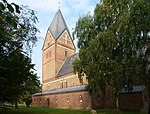SS Cap Arcona, named after Cape Arkona on the island of Rügen, was a large German ocean liner, later a ship of the German Navy, and finally a prison ship. A flagship of the Hamburg Südamerikanische Dampfschifffahrts-Gesellschaft ("Hamburg-South America Line"), she made her maiden voyage on 29 October 1927, carrying passengers and cargo between Germany and the east coast of South America, and for a brief period of time she was the largest and fastest ship on the route, until one month later she was surpassed on the same Europe-South America route by the Italian liner MS Augustus (1926).
In 1940 the Kriegsmarine requisitioned Cap Arcona as an accommodation ship. In 1942 she served as the set for the German propaganda feature film Titanic. In 1945 she evacuated almost 26,000 German civilian refugees from East Prussia before the advance of the Red Army.
Cap Arcona's final use was as a prison ship. In May 1945 she was heavily laden with prisoners from Nazi concentration camps when the Royal Air Force bombed her, killing about 5,000 people; with more than 2,000 further casualties in the sinkings of the accompanying vessels of the prison fleet, Deutschland and Thielbek. This was one of the largest single-incident maritime losses of life in the Second World War.








